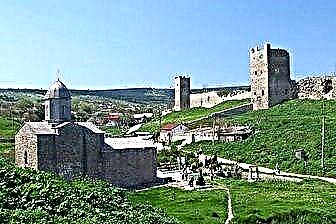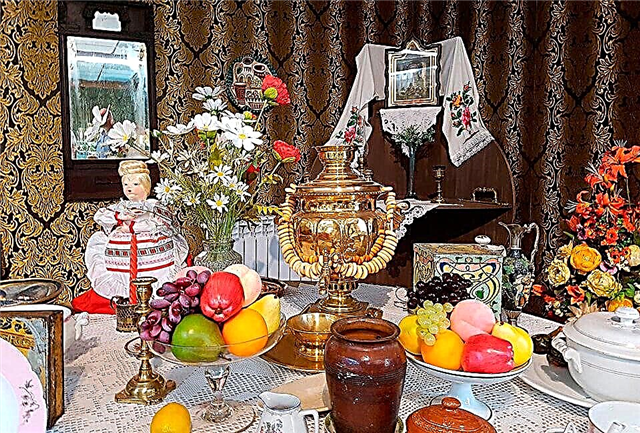Kolomna is poetry in stone, on which people began to work back in the days of Ancient Rus. However, the work is still unfinished today. The invincible fort, the favorite city of Dmitry Donskoy, the ancient center of Orthodoxy and just a beautiful city standing at the confluence of the stormy streams of the Oka and the Moskva River - this is definitely worth a visit if you are planning a trip to Russia.
Kolomna's museums reflect its spirit in the best possible way - in places merchant, partly revolutionary, having seen too much in its lifetime, it continues to gather thousands of tourists who are ready to plunge headlong into the world of colorful landscapes and monuments of gray-haired antiquity.
Kolomna Kremlin

A trip to Kolomna will already look quite complete if you can get a glimpse into the local Kremlin. According to historians, this mighty structure was built mainly in the fifteenth century. It is recommended to take at least half a day to visit it, since in addition to the strong walls and perfectly preserved towers, there are still many unique architectural and historical structures.
Among the most significant buildings of the Kolomna Kremlin are the Assumption Brusensky Convent, the Tikhvin Church, the Church of the Exaltation of the Cross and other religious buildings that appeared here almost simultaneously.
It is better to use the services of a guide to get more information that is easy to miss when traveling alone. And the material promises to be really rich.
Museum "Kolomenskaya Pastila"

This Kolomna museum has set itself a rather unusual goal - to preserve art in its ephemerality. Not plasticity of form or saturation of color, but smell, taste, manner of conversation, peculiarities of life. Anything that tends to naturally change over time.
The museum was opened relatively recently - only in 2009. The territory of the Kolomensky Posad was chosen for its location. An outbuilding of an ancient merchant estate right next to the Church of St. Nicholas on Posadi was given to the museum.
Kolomna pastille is a tiny, absolutely special corner of silence that comes to life only under the striking of an old clock and the piercing trill of a canary. The hospitable hostess is always glad to guests - she will offer you dozens of varieties of marshmallows and will gladly share the legends of antiquity, in which the formidable figure of Ivan the Great and the mysterious Masons who, as usual, gathered in the Suranovs' house, will come to life.
She will also not forget about the miraculous apples that grew in the gardens of Bishop Nikita, and about the main guest of the table - about the Kolomna marshmallow.
Museum "Kalachnaya"

The pride of Kolomna, near Moscow, is a museum that is iconic for this ancient Russian city. Kalachnaya stands right next to the Pyatnitskaya Tower. The old Kolomna kalachny craft is gradually reviving here.
In a certain sense, the museum can be called alive, since the object of the museum display was the sequential process of baking rolls from the moment of making the sourdough on hops to cutting the dough on an ice table, then sending the fragrant pastry directly to the oven blazing with heat. Local rolls are baked in an oven specially designed according to the drawings of the nineteenth century, which is heated exclusively with birch wood.
It is believed that in this way the rolls will acquire additional whiteness. Why is the opening of this museum important? In fact, the kalachny trade has practically lost its historical roots in Murom, Moscow and in Kolomna itself.
What today is proudly called kalach has nothing to do with its historical prototype, which was by no means considered sweet. To restore the old recipe, a large-scale work was carried out with the archives of the last three centuries.
Museum of Organic Culture

The very concept of organic culture appeared in the first third of the twentieth century thanks to Mikhail Matyushin, who made a significant contribution to the art of this period. Not many museum visitors immediately associate it with the Russian avant-garde, since this direction was rather closed even during its most turbulent stage of development.
Representatives of this trend believed that the world should be perceived exclusively as an integral (organic) system, at the head of which are "Order, Law and Becoming".
The Contemporary Museum of Organic Culture has three halls: the Museum of Tradition, the Museum of Photography and the Museum of Art. Here is a rich collection of works by Russian avant-garde artists, in particular, E. Guro, M. Matyushin, P. Kondratyev.
Oddly enough, the pillars of organic culture, which are not particularly widely known in Russia, are well known in the West. Many of their works are in the best museums in the world.
Museum of Military Glory

As in many other cities of Russia, Kolomna has its own museum dedicated to military service. Kolomna is undoubtedly an ancient city - its inhabitants constantly found themselves in the thick of military events, starting from the times of Ancient Rus and right up to the tragic pages of the Second World War.
It is not surprising that it was decided to preserve the feats of the people in the memory of posterity. Initially, the church of Peter and Paul was given to house the museum, but after the fall of the Soviet Union, the temple returned to believers again, and the museum was moved to a new building in a futuristic style with a red glass facade symbolizing feats and military prowess.
Favorite Toy Museum

This private gallery is one of the youngest museums in Kolomna. It opened only in 2014 and is located on the territory of the Kolomna Kremlin. The gallery was opened at the initiative of Irina Kulikova, who collects toys and creates them herself.
Before the opening of the museum, she was mainly engaged in the restoration of old toys, which she bought in antique shops, at auctions and even just on the Internet. Oddly enough, but the opening of the museum, the craftswoman was inspired by a visit to the pastel museum, which is also difficult to call traditional.
Today, the museum's collections are represented mainly by toys of the nineteenth and twentieth centuries. And it's not only about plush animals, but also about numerous dolls.
The most significant of the foreign examples is the porcelain boudoir doll. A separate exposition is dedicated to dolls of Russian manufactories: "Gudkov", "Gzhel", "Dunaev" and so on.
Museum "Kolomna gramophone"

We have already managed to find out that Kolomna can be deservedly considered the homeland of marshmallows. It's time to add gramophones to this list. Yes, it is the gramophones that began to be produced on an industrial scale in Kolomna at the beginning of the twentieth century.
Initially, on the site of the plant, which just a year later began to thunder throughout the country, there was an old silk-spinning factory. Local specialists did not limit their imagination. First on paper, and then in reality, more and more incredible versions of gramophones began to appear.
For example, once at the plant it was decided to start producing gramophones, which were filled with "talking paper".
The Second World War did not bypass the Kolomna production - the scale began to decline, creative ideas were not needed by anyone. But the old Kolomna gramophones turned out to be surprisingly useful, filling the soldiers' dugouts with sweet sounds.
Museum "Kuznechnaya Sloboda"

This museum was opened in 2010 and is a private collection of artifacts. Basically, the collections turned out to be exhibits that belonged at one time to Ilya Lebedev, who began to collect it more than twenty years ago.
These are forged, wooden and cast products that belong to different eras. Despite the fact that the collection was originally private, it is absolutely impossible to call it small in number - the modern museum fund is about seven thousand exhibits.
Once in the museum halls, you will not only get to know more about the peculiarities of culture and life in certain historical segments, but you will also be able to feel a little deeper the very flavor that cannot be overlooked when visiting, for example, the village blacksmith's shop, hut or stables. It also houses a large collection of armor and weapons of bygone times, as well as a variety of devices that were used in hunting and fishing.
Artkommunalka

that unusual museum takes responsibility for telling its guests in colors how the life of a Soviet person looked like in the sixties of the last century. Get ready to find yourself in a typical Thaw-era Khrushchevka with a distinct communist spirit and unsettling notes of dissidence.
The museum occupies a house in old Kolomna, where Venedikt Erofeev once lived. In the same house on the ground floor, the Ogonyok store was once opened, in which he, in fact, worked as a loader. The universally recognized genius and fighter for creative freedom today Erofeev made this place the way we know it now.
The "communal space" of the museum is occupied by living rooms and workshops. The art-residence is never empty. Here, artists and masters of words live alternately, who, with the determination of the creator of this place, are fighting for a new look at art. Exhibitions and art installations are also held here.
Artkommunalka often receives guests from abroad. For example, recently there was an exhibition of works by an artist from South Korea - Lee Sujin, who gave a lecture on the interaction of video series, performance and text.
Museum of local lore

Kolomna Museum of Local Lore is deservedly considered one of the oldest in the region. Its discovery fell on 1932. Initially, it is located on the territory of the Kremlin, but later the former Church of the Archangel Michael was transferred to the property of the museum.
The museum fund is impressive - there are about thirty thousand exhibits that were brought here from all local archives, private collections, and similar museums. The material collected here gives the fullest possible idea of the culture, history and nature of the Kolomna region, starting from the most ancient period in the history of mankind.
Over the past twenty years, a number of historical buildings have been transferred to the management of the museum. Of these, the most important are the 19th century merchant manor complex, the 17th century governor's house and the eighteenth century Lazhechnikovs' manor house.
The estate of the merchants Lazhechnikovs

Unfortunately, today the name of the merchant Lazhechnikov is known to few. And few people will remember that this man was successful not only in the merchant business, but also in literature. Moreover, he was a kind of pioneer - it is with his name that the discovery of a new genre in Russian literature is associated - the historical novel.
His family estate is located today right in the center of Kolomna. If you decide to visit this museum, you will be lucky enough to try to lift a pound weight, taste real mead, taste marshmallow sitting at a table covered with a hand-knitted tablecloth, and even learn how to use a ruble.
Local interactive programs deserve special mention. Silent films based on the novel by Lazhechnikov's "Ice House" are regularly held here, and various plays are performed to show what the life of the merchants looked like in the nineteenth century.
Tram Museum

The Zamoskvoretsky distance is spread out in front of you, the monument to Cyril and Methodius freezes in all its glory, and Cathedral Square is so wide! .. Walk a little forward to turn into a quiet and somewhat secluded street of Dmitry Donskoy, because this is where the only tram museum in all of Russia is located.
From the street, it is almost impossible to understand how unusual collection this museum keeps - an ordinary house built of wood back in the nineteenth century. The location for the opening of the museum was not chosen by chance. It was here - at the end of the nineteenth century - that the country's first tram car was created.
Production is still open, which automatically makes this city the only one in Russia where a tram company has been operating for such a long period of time. However, this is not surprising, because today the tram business is experiencing a real renaissance.
Museum "House of the Samovar"

The small Kolomna Museum is a colorful Easter egg under low arches with dozens of flat and pot-bellied, high and low, round and rectangular samovars. Such an impressive collection is based on a private collection of the Burov family.
In addition to samovars, the museum also donated old kerosene lamps, irons, jewelry and vintage clothing. The Drilling family managed to leave a truly complete collection of things that tell in color about the culture and life of the nineteenth century.
Once in this museum, you are guaranteed to dispel a couple of popular misconceptions for yourself. Suffice it to note that samovars appeared not in Mother Russia, as one might assume, but in Asia. We are talking first about Ancient China, and only then about Iran and other countries.
In Russia, the samovar appeared only by the eighteenth century, but it became so firmly established in the life of a Russian person that it is almost impossible to imagine them in isolation.
Museum "Secrets of Kolomna Mead"

Honey brewing and beekeeping have always been at the head of the galaxy of crafts for which Kolomna was famous. So that the traditions of the past centuries are not forgotten, the Museum "Secrets of Kolomna Mead" was opened. The wing of the house of the famous local merchant and philanthropist Makeyev was chosen to accommodate it.
The organizers of the museum have done a great job on the restoration of the wine cellars, having managed to create in them an atmosphere characteristic of the era of their foundation. Mead was once called a cellar in which honey drinks were stored.
Hence the name of the museum. The excursion usually takes place in the company of a housekeeper, a mead brewer and a beekeeper, who acquaint guests with the history of beekeeping, talk about how the image of honey has changed in epics and chronicles.
During the excursion, you could taste different types of honey on your own. At the end of your visit to the museum, you can visit the local shop, which sells products made from honey - from gingerbread to honey wines.
Museum of Flax and Russian Woman's Life

This museum is located in the historical part of the city, in close proximity to Kuznechnaya Sloboda. The museum's collections contain numerous towels, spinning wheels and Russian costumes from different eras. The guide will tell you how a tiny linseed grain turns into thin, light-colored clothes.
You will take a closer look at the process of making yarn using a loom, spinning wheel and spindle. At the end of the excursion, you can stay for one of the regularly held master classes, where you can try to make yourself a small souvenir from flax or a linen doll as a talisman.
If you don’t want to make a souvenir or don’t have enough time to spare, you can drop by the museum shop and buy handicrafts.










